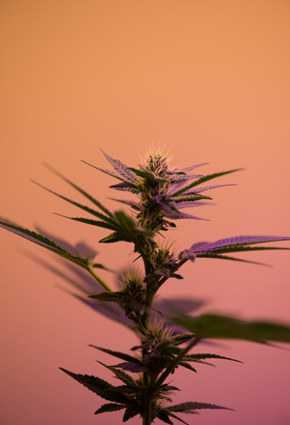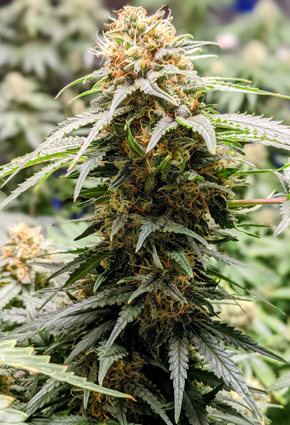If you’re dealing with hemp for the first time, a variety of terms can be overwhelming. Cannabis Indica, Sativa, Ruderal-Hemp – how can such names be distinguished from one another? We not only explain the difference between Sativa and Indica, but also help you find the right strain for your needs!
Cannabis Sativa - The intricacies of the creative strain
The most famous cannabis plant is Cannabis Sativa. Its leaves appear elongated, narrow, its native countries include Jamaica, Mexico, Thailand and Colombia.
Today, most cannabis plants are hybrid varieties, there are only a few pure cannabis sativa varieties. One of the most famous representatives is Dutch Haze.
Sativa cannabis strains have a particularly high THC content (delta 9 tetrahydrocannabinol) and deliver large yields. The primary effects of the Sativa plant are as follows:
- cerebral high with motivational elements.
- appetite stimulation and reduction of stomach and intestinal complaints
- increase of the sense of well-being
- Strengthening of attention, enhancement of concentration
- Creativity booster


Cannabis Indica - the second most important strain
According to legend, a man named Jean Baptiste de Lamarck is the discoverer of Indica plants. Visually, they are much smaller than cannabis sativa, and there are also clear differences in potency between sativa and indica varieties. Especially the high amount of CBD makes Indica varieties stand out, which is why they are seen as antagonists to Sativa. If Sativa whips up the mind, Indica provides the resting pool. Pure sativa plants are rare today, the combined effect of both strains has prevailed. Indica strains produce the primary effects as follows:
- Improved falling asleep and staying asleep
- Sedative effect to reduce anxiety and stress
- Increase of appetite
- Improvement of inflammatory diseases, promotion of the immune system
Cannabis Ruderalis - the great unknown among cannabis plants
Cannabis Indica and Sativa are not only the two most important, but also the best known varieties. However, in cooler regions like Siberia and Russia, a third variety grows that is hardly known in this country. It is Cannabis Ruderalis, a fast-growing plant that flowers without fertilization. It has no significance for the production of local cannabis products, but botanists are still interested in it.
In particular, Cannabis ruderalis could have increased importance in medicinal applications. It contains large amounts of CBD and is naturally low in THC. Ruderalis is therefore not uninteresting for studies regarding CBD effects and first hybrids already exist.


Distinguishing visually between Indica and Sativa strains of cannabis
The difference between Indica and Sativa plants can be noticed at first glance. The Sativa plant is primarily of interest for the production of (medical) cannabis with a high THC content. It is tall with finger-like leaves, and its flowers are larger compared to an Indica plant, resulting in a more bountiful harvest.
The flowers of the Indica plant are larger and airier. Indicas are generally considered easier to cultivate, and they play an important role in the production of medical cannabis because patients can benefit from its calming and pain-relieving effects.
What suits me? Indica or Sativa?
Generally, you need to differentiate between different cannabis products. Medical cannabis can be sativa or indica, but is prescribed by a doctor. Legal cannabis strains contain little or no CBD (maximum 0.2%), but still bring different effects.
Sativa-dominant CBD differs not only in appearance, but also in potency. Consumers who want to be stimulated and motivated by CBD flowers primarily turn to sativa strains.
On the other hand, if you crave tranquility and relaxation, an indica strain might be a better choice. Many patients report that indica cannabis is especially helpful for restlessness, anxiety, and even pain.

More and more hybrids - the Sativa-Indica difference takes a back seat
Initially there were clear distinguishing characteristics between Cannabis Sativa and Indica, but nowadays there are more hybrids. These are crosses of Indica/Sativa, bringing together the best characteristics of both plants. This means they can have the potential of a Sativa strain, but grow quickly like an Indica.
For some species, the origin is no longer so clear and the distinction is less important. The focus is mainly on the effect and this is usually determined individually for each strain.
CBD strains - no high and still effective
Classical marijuana dominates due to its psychoactive effect. In Germany, it can only be consumed if doctors have prescribed it to reduce symptoms. However, the cannabinoid CBD is completely legal in Germany, Austria, and Switzerland. While it changes the way it works when no “high” is achieved, patients still report positive effects.
Researchers are still partially puzzled about the basis of the effect. Currently, natural scientists around the world are working to decipher the influence of cannabinoids on the human brain and body. We already know that Sativa strains increase creativity and Indicas contribute to more relaxation. Researchers still need to find out what influence the typical properties of marijuana with THC have on CBD strains.
In fact, especially with CBD, it seems that the genetics of the strain that it belongs to plays a less significant role. Instead, what terpenes the hemp plant brings along is more important.


What is CBD used for?
The composition of CBD flower is not primarily different from classic cannabis. The main difference is that the THC content is below 0.2%. A crucial role seems to be played by terpene, which occurs naturally in commercial hemp plants. In synergy with cannabinoids such as CBD, CBC and CBN, the so-called entourage effect is created, which is very popular in the application.
So far, the application of CBD is mainly based on user knowledge. There are numerous areas of use for modern CBD strains:
- psychological complaints such as anxiety, depression, inner restlessness, Burnout
- sleep disorders and difficulty falling asleep
- lack of appetite, gastrointestinal complaints
- in animals with restlessness and nervousness
- relief of skin complaints (topical application)
- interruption of pain transmission
- reduction of acute and chronic inflammations
Conclusion: Sativa-Indica difference in CBD is not very significant
The Indica-Sativa difference mainly plays a role in Cannabis and medicinal hemp. As CBD has no psychoactive effect, the stimulating or sedative effects are rather suppressed. Instead, the effectiveness of CBD focuses on the interaction of terpenes and cannabinoids.
The potency of CBD itself is more decisive than the actual genetics of the plant. The difference in the production of medicinal hemp is much more important.
The question remains as to whether the new strain (Cannabis Ruderalis) can establish a permanent place in the market. So far, Sativas and Indica strains are much more popular. However, due to the high CBD content, Ruderalis could also play a larger role in the long run. The only problem seems to be the cultivation, as Ruderalis primarily grows in cooler regions such as Russia. If new CBD strains appear, you will definitely find out about it from us very quickly!


